Koppenbrüllerhöhle
Useful Information
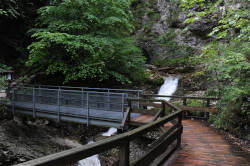
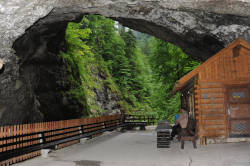
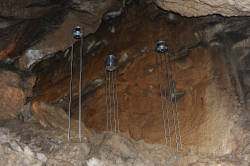
| Location: |
Obertraun
A1 (E55) exit 234 Gmunden, follow B145 through Gmunden, Bad Ischgl, and Bad Goisern. Behind Bad Goisern turn right onto 166 to Gosaumühle, turn left along Hallstatt lake through Hallstadt to Obertraun. Starting at the railway station Obertraun - Koppenbrüllerhöhle or the parking lot at the restaurant Koppenrast a track leads in 15 min. walk to the cave. + (Kat 1549/1) (47.570391, 13.720360) |
| Open: |
MAY to SEP daily 9-16. [2025] |
| Fee: |
Adults EUR 18.30, Children (15-17) EUR 16.50, Children (6-14) EUR 10.10, Senior (65+) EUR 17.40. Kleine Abenteuerführung (short adventure tour): Adults EUR 46, Children EUR 34.60, School pupils EUR 27.60. Urwassergänge: Adults EUR 70.30, Children EUR 38.70, School pupils EUR 38.70. [2025] |
| Classification: |
 Karst Cave Karst Cave
 River cave River cave
 Karst Spring Karst Spring
|
| Light: | torch provided |
| Dimension: | L=4,054 m, VR=107 m, A=580 m ü.A., T=6 °C. |
| Guided tours: |
D=50 min, L=565 m.





Kleine Abenteuerführung (short adventure tour): D=90 min, MínAge=8, Min=4, Max=20. Urwassergänge: D=2.5 h, Min=4, Max=10, MinAge=12. |
| Photography: | allowed |
| Accessibility: | no |
| Bibliography: |
Ing Hermann Bock et al. (1913):
Höhlen im Dachstein und ihre Bedeutung für die Geologie, Karsthydrographie und die Theorien über die Entstehung des Eises,
Dem Andenken weiland Prof Friedrich Simonys. 151 pp some fine sepia photos, illus, maps etc. HB 
Die Engl-Höhle In: Iolanthe Hasslwander, Sagenschatz aus dem Salzkammergut, Steyr 1981 online 
|
| Address: |
Dachstein Tourismus AG, Customer Service Team, Winkl 34, 4831 Obertraun am Hallstättersee, Tel: +43-50-140.
E-mail: |
| As far as we know this information was accurate when it was published (see years in brackets), but may have changed since then. Please check rates and details directly with the companies in question if you need more recent info. |
|
History
| 1776 | the deserter Franz Engl used this cave as hideout. |
| 1820 | mentioned in an early tourist guidebook about the Salzkammergut as "berühmte Schauhöhle" (famous show cave). |
| 19th century | Friedrich Simony did some geological research in this cave. |
| 1910 | development of the cave, paths and begin of regular guided tours. |
| 1973 | declared a natural monument. |
| 2007 | start of renovation of all three caves by the Kunstuniversität Linz, Institut für Raum- und Designstrategie. |
| MAY-2008 | renovation completed. |
Description
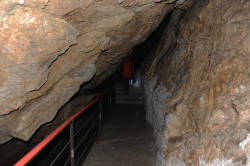
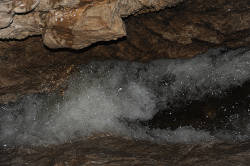
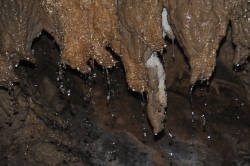
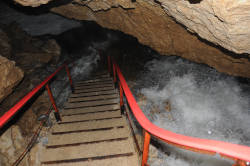
The Koppenbrüllerhöhle lies between Sarstein and Koppengebirge, the northern foothills of the Dachsteinplateau. The cave entrance opens in the gorge of the Traun river. Depending on the weather a large karst source arises either from the cave portal or in the bed of the brook below. The cave river turns into a roaring stream when the snow melts in spring or after heavy rains, this is how the cave got its name. Brüller comes from the German word brüllen (shout, roar), and the spring is definitely roaring at high water. The other part, Koppen is derived from the mountain chain it is located at, the Koppengebirge (Koppen mountains). So you could translate the name as the roaring spring at the Koppen mountains. However, the name is rather old and even a local would need some time to take it apart this way.
In the times of the Austro-Hungarian Empire, during the reign of Kaiserin Maria Theresia, a deserter from the Austrian army named Franz Engl used this cave as hideout. He could see people entering the cave without being seen himself by simply looking at the reflection of the entrance in the water. Of course, this phenomenon can still be observed today! His dear wife Josefa, called Hofer Sef, brought him food, until she eventually got very sick. He cared for her, but finally she died. So he asked the priest to come to the cave and give her the sacrament. The priest was so moved by this tragedy, he asked for amnesty for Franz Engl which was given.
The cave entrance is formed like a siphon. From the huge portal the passage goes first down, then up again. This lower part is frequently flooded and so the cave was frequently inaccessible after heavy rains. More dangerous is the problem of tourist groups on a tour which are not able to leave the cave because the entrance has flooded. To solve this problem a small artificial entrance tunnel was built which connects the higher entrance with the higher passage behind. This allows cave visits independent of the water level. But during times of low water level the lower section is part of the cave tour.
The cave visitors meet at the blockhouse which was built into the cave portal. The house is ticket office and lounge for the cave guides, in former times also storage for the carbide lamps. The cave has no electric light, which would be destroyed by the frequent floods. Instead, the cave tours were made for decades with carbide lamps. Today the carbide lamps are replaced by LED lamps.
Right after the entrance the path leads through a labyrinthic series of passages and small chambers. Like the other caves in the Dachstein the cave is used as an exhibition space for modern art. Quite impressive is a set of drums which are placed under drip points and make the drops audible. The Hannakluft, the last hall of the tour, has a different character. The passage is mostly horizontal but inclined at a 45° angle. On the left side, beneath the path, the cave river flows, which fills the cave with a loud noise.
The cave had long been known to the locals and was explored as early as the 19th century. Nevertheless, it is somewhat curious that it is mentioned as a "famous show cave" in a travel guide to the Salzkammergut from 1820. It can be assumed that locals offered guided tours, but the cave was not developed in any way at the time. The famous naturalist Dr. Friedrich Simony, who explored primarily the Dachstein area, made scientific studies in the cave. Ten years after Simony’s death, Hermann Bock began exploring the cave. In honour of Simony, he named several parts of the cave after him: the Simonygalerie (Simony Gallery), the Simonyhalle (Simony Chamber) and the Simonykapelle (Simony Chapel). In the cave the blind cave beetle Arctaphaenops angulipennis Meixner was found for the first time, so it became type locale for this troglobiont. It made the cave rather famous among biologists.
The Koppenbrüllerhöhle is the lowest and youngest part of the Dachstein caves. While the other caves are fossil levels, this lowest level is the active, water filled part of the caves. A huge part of the Dachstein massif is drained by this cave.
 Search DuckDuckGo for "Koppenbrüllerhöhle"
Search DuckDuckGo for "Koppenbrüllerhöhle" Google Earth Placemark
Google Earth Placemark Koppenbrüllerhöhle - Wikipedia (
Koppenbrüllerhöhle - Wikipedia ( Koppenbrüllerhöhle - Tosendes Wasser (visited: 01-AUG-2021)
Koppenbrüllerhöhle - Tosendes Wasser (visited: 01-AUG-2021) Index
Index Topics
Topics Hierarchical
Hierarchical Countries
Countries Maps
Maps